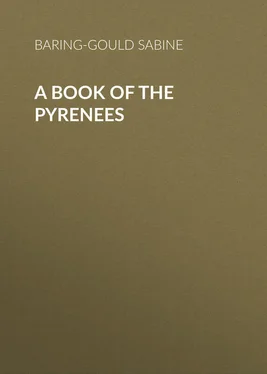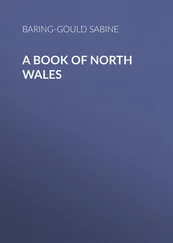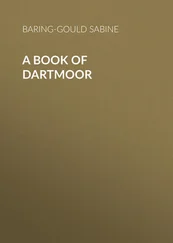Sabine Baring-Gould - A Book of the Pyrenees
Здесь есть возможность читать онлайн «Sabine Baring-Gould - A Book of the Pyrenees» — ознакомительный отрывок электронной книги совершенно бесплатно, а после прочтения отрывка купить полную версию. В некоторых случаях можно слушать аудио, скачать через торрент в формате fb2 и присутствует краткое содержание. Жанр: foreign_antique, foreign_prose, на английском языке. Описание произведения, (предисловие) а так же отзывы посетителей доступны на портале библиотеки ЛибКат.
- Название:A Book of the Pyrenees
- Автор:
- Жанр:
- Год:неизвестен
- ISBN:нет данных
- Рейтинг книги:5 / 5. Голосов: 1
-
Избранное:Добавить в избранное
- Отзывы:
-
Ваша оценка:
- 100
- 1
- 2
- 3
- 4
- 5
A Book of the Pyrenees: краткое содержание, описание и аннотация
Предлагаем к чтению аннотацию, описание, краткое содержание или предисловие (зависит от того, что написал сам автор книги «A Book of the Pyrenees»). Если вы не нашли необходимую информацию о книге — напишите в комментариях, мы постараемся отыскать её.
A Book of the Pyrenees — читать онлайн ознакомительный отрывок
Ниже представлен текст книги, разбитый по страницам. Система сохранения места последней прочитанной страницы, позволяет с удобством читать онлайн бесплатно книгу «A Book of the Pyrenees», без необходимости каждый раз заново искать на чём Вы остановились. Поставьте закладку, и сможете в любой момент перейти на страницу, на которой закончили чтение.
Интервал:
Закладка:
S. Baring-Gould
A Book of the Pyrenees
This Book of the Pyrenees follows the same lines as my Book of the Rhine and Book of the Riviera . It is not a guide, but an introduction to the chain, giving to the reader a sketch of the History of the Country he visits.
CHAPTER I
THE PYRENEAN
The wall of division – A triple chain – Contrasts – Deforesting – The Catalan of Roussillon – The Basque of Navarre – Roman roads – The three ports – Central ridge – Trough to the north – Watershed – Glacial moraines – Lakes – Cirques – Abrupt termination of the lower valleys – Cave dwellers – Dolmens – That of Buzy – Landes of Pontacq – The Iberian stock – Development of language – Auxiliary verbs – The Basque villages and people.
The Pyrenees stand up as a natural wall of demarcation between two nations, the French and the Spaniards, just as the mountains of Dauphiné sever the French from the Italians. It has been remarked that these natural barriers are thrown up to part Romance-speaking peoples, whereas the mountain ranges sink to comparative insignificance between the French and the Germans. Over the Jura the French tongue has flowed up the Rhone to Sierre, above the Lake of Geneva, so the Spanish or Catalan has overleaped the Pyrenees in Roussillon, and the Basque tongue has those who speak it in both cis-Pyrenean and trans-Pyrenean Navarre. The Pyrenees are the upcurled lips of the huge limestone sea-bed, that at some vastly remote period was snapped from east to west, and through the fissure thus formed the granite was thrust, lifting along with it the sedimentary rocks.
Consequently the Pyrenees consist of from two to three parallel chains. The central and loftiest is that of granite, but where loftiest is hidden on the north side by the upturned reef of limestone. On the south the calcareous bed is lifted in great slabs, but split, and does not form so ragged and so lofty a range.
The Pyrenees start steeply out of the Mediterranean, which at a distance of five-and-twenty miles from Cape Creuse, has a depth of over 500 fathoms, and there the limestone flares white and bald in the line of the Albères. But to the west the chain does not drop abruptly into the Atlantic, but trails away for 300 miles, forming the Asturian mountains, and then, curving south, serves to part Galicia from Leon. The range of the Pyrenees dividing France from Spain is 350 miles in length.
The chain to the west wears a different aspect from that in the east. The Basque mountains are clothed with trees, pines and birch, walnut and chestnut, and above them are turf and heather. But the eastern extremity is white and barren. This is due to the fact that the Western Pyrenees catch and condense the vapours from the Atlantic, whereas the Oriental Pyrenees do not draw to them heavy and continuous rains. The boundary between the regions and climates is Mont Carlitte. In the Western Pyrenees the snow line lies far lower than in the east. On the former of these glaciers hang in wreaths, whereas there are none in the east.
The contrast between the northern and southern slopes is even more marked than that between the extremities of the chain. On the French side are snow, ice, running streams, fertile vales, luxuriant meadows and forests, and valleys and hillsides that sparkle with villages smiling in prosperity. But on the southern slope the eye ranges over barren rocks, sun-baked, scanty pastures, and here and there at long intervals occur squalid clusters of stone hovels, scarce fit to shelter goats, yet serving as human habitations.
To the mountaineers the French side is bach , that in shadow; the Spanish is soulane , the sunny. At one time this latter slope was not as arid and desert as at present, but the thriftlessness of man has shorn down the forests and the teeth of the goats have nipped off or barked every seedling or sapling thrown up by nature to cover its nakedness and redress the evil. Thereby the rainfall has been diminished, and the soil is exposed to be carried away into the plain by every storm that breaks over the heights. 1 1 É. Reclus: Géographie universelle , II. “La France.”
Trees are the patient workers that reconstitute the flesh over the bones of the mountains. They derive their elements from the air and the rock, and they perform transformations far more wonderful than those attributed to the philosopher’s stone. As Victor Hugo sang: —
“Les arbres sont autant de mâchoires qui rongent
Les aliments épars dans l’air souple et vivant;
Ils dévorent la pluie, ils dévorent le vent.
Tout leur est bon: la nuit, la mort. La pourriture
Voit la rose, et lui va porter sa nourriture.”
When the trees disappear from a country it shows the thriftlessness of the inhabitants – “sufficient unto the day is the evil thereof”; with the axe and the firebrand they destroy in a day what it will take centuries to replace.
Two non-French races occupy the extremities of the chain and the lowlands at its feet. In the Basses Pyrénées are the Basques, in Pyrénées Orientales are the Catalonians, speaking a dialect of the Spanish of Barcelona.
The whole of Aquitaine, from the Loire to the Pyrenees, the whole of Western Spain and Portugal, was once occupied by the Iberians, of whom the Basques are the shrunken residue. All Eastern France and Eastern Spain were overflowed by the Celts. The Romans recognized that Spain was in the possession of two races totally distinct, ethnographically and linguistically, and they termed the population of the peninsula Celtiberians.
When the Romans arrived on the scene they carried one main causeway from Arles to Narbonne, and thence to Toulouse, and from Toulouse to Dax. From this, roads branched to the south and crossed the Pyrenees into Spain by three gaps, natural doorways – one to the east, the easiest of all, by Le Perthus, where Pompey set up a trophy; one by Somport leading from Iluro (Oloron) to Saragossa; a third by Roncevaux to Pampeluna.
By the first of these ports Hannibal crossed from Spain on his way to Italy; by it also poured the Saracens to devastate the fields of Gaul. By Roncevaux Charles the Great passed to menace the Saracen power, and on his return met there with disaster at the hands of the Basques, which has been immortalized in song.
East and west were debatable lands. Navarre sat astride on the ridge, with a foot in Spain and the other in Gascony. To the east was Roussillon, that pertained to the kings of Aragon, till ceded definitely to France in 1659.
But to revert to the geological structure of the Pyrenees. The central chain is, as already said, composed of crystalline rocks, granite, and micaceous schist, whereas the northern chain exhibits the upturned beds of superincumbent deposits, and on the Spanish side the limestone lies on the granite. In the department of Haute Garonne the chains are soldered together by a transverse bar of mountain.
J. H. Michon, author of Le Maudit , says well: —
“These mountains reveal to me almost the entire history of the successive periods in the terrestrial crust. I have but to follow the torrent of the Arbouste, and mount to the Lac de Seculéjo, and push farther to the Pic d’Espingo, to find myself on the crest of the ridge dividing France from Spain. Often at these altitudes, reaching to 3000 metres above the sea, the prodigious force which has rent the terrestrial crust in a fault of eighty leagues in breadth, which has upheaved, as in the Marboré, enormous masses of limestone that once formed the basin of seas succeeding each other at different epochs – often has this phenomenon filled me with amazement. There in the Marboré lie the beds, retaining their horizontality, as though the aqueous deposits had been formed at this great elevation.
Читать дальшеИнтервал:
Закладка:
Похожие книги на «A Book of the Pyrenees»
Представляем Вашему вниманию похожие книги на «A Book of the Pyrenees» списком для выбора. Мы отобрали схожую по названию и смыслу литературу в надежде предоставить читателям больше вариантов отыскать новые, интересные, ещё непрочитанные произведения.
Обсуждение, отзывы о книге «A Book of the Pyrenees» и просто собственные мнения читателей. Оставьте ваши комментарии, напишите, что Вы думаете о произведении, его смысле или главных героях. Укажите что конкретно понравилось, а что нет, и почему Вы так считаете.












